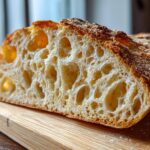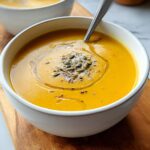Ciabatta bread has always felt like a little piece of Italy right in my kitchen. My first attempt? Let’s just say it resembled a hockey puck more than the airy loaf I was dreaming of! But I was determined to master it. After countless tries (and a LOT of flour), I finally nailed a recipe that gives you that perfect crispy crust and soft, hole-y inside. This isn’t just any bread; it’s an experience. I like to add a touch of rosemary to my dough for that extra bit of aroma and flavor that just screams “homemade.” The smell alone, baking in the oven, is enough to make my day. If you’re looking for an easy ciabatta bread recipe for beginner bakers, you’ve come to the right place. Let’s get cooking.
Why You’ll Love This Ciabatta Bread
- The crust is unbelievably crispy, and the inside is light and airy—the perfect texture combo!
- It’s surprisingly easy to make at home (trust me, if I can do it, you can too!).
- Freshly baked, it tastes incredible with just olive oil and a sprinkle of sea salt.
- This simple Italian bread elevates any sandwich to gourmet status.
- It’s way cheaper than buying it from a bakery – and tastes even better!
- You control the ingredients, so no weird additives or preservatives.
- The aroma of baking ciabatta will make your kitchen smell divine.
Ingredients for Perfect Ciabatta Bread
- 4 cups all-purpose flour: This forms the base of our dough. For a chewier crumb, try using bread flour instead!
- 1½ cups warm water (110°F): The warmth activates the yeast, but make sure it’s not too hot, or you’ll kill it.
- 2¼ teaspoons active dry yeast: This is what gives our ciabatta loaf that beautiful rise and airy texture. Make sure it’s fresh!
- 2 teaspoons salt: Enhances the flavor and controls the yeast activity. Don’t skip it!
- 2 tablespoons olive oil: Adds richness and helps create that signature crust. Extra virgin olive oil will give you the best flavor.
How to Make Authentic Ciabatta Bread
- Step 1: In a large bowl, mix together 4 cups of all-purpose flour and 2¼ teaspoons of active dry yeast. Make sure the yeast is evenly distributed; this is key to a good rise!
- Step 2: Add 1½ cups of warm water (around 110°F) while stirring. The dough will start to come together and look shaggy. Don’t worry, that’s exactly what we want!
- Step 3: Turn the dough out onto a lightly floured surface and knead for about 10 minutes. It should become smooth and elastic. If it’s too sticky, add a little flour, a tablespoon at a time. This kneading step is crucial for developing that classic ciabatta bread texture!
- Step 4: Place the dough in a lightly oiled bowl, turning to coat. Cover the bowl with a damp cloth and let it rise in a warm place for about 2 hours, or until it has doubled in size. Trust me, watching it grow is part of the fun!
- Step 5: Gently punch down the dough to release the air. Divide it into two equal pieces and shape each piece into a rectangular loaf. Don’t overwork the dough; we want to keep those air pockets!
- Step 6: Transfer the loaves to a baking sheet lined with parchment paper. Cover them loosely with a cloth and let them rise again for another hour.
- Step 7: Preheat your oven to 450°F (230°C). Drizzle the loaves with olive oil and sprinkle with sea salt. The olive oil helps create that gorgeous golden crust, and the salt adds a burst of flavor.
- Step 8: Bake for 25-30 minutes, or until the loaves are golden brown and sound hollow when tapped on the bottom. The aroma filling your kitchen will be absolutely irresistible! Let your delicious ciabatta cool on a wire rack before slicing and enjoying.
Pro Tips for the Best Homemade Ciabatta Bread
Want to take your ciabatta game to the next level? Here are a few tricks I’ve picked up over the years. Trust me; these will make all the difference in achieving that bakery-quality loaf at home!
- Use a baking stone or preheated baking sheet for an extra crispy crust.
- Don’t skip the second rise! It’s essential for developing the airy texture.
- Handle the dough gently to avoid deflating those precious air bubbles.
- A little steam in the oven can work wonders. Try placing an oven-safe dish with hot water on the bottom rack during baking.
What’s the secret to perfect Ciabatta Bread?
It’s all about the hydration! Ciabatta dough is notoriously wet, and that’s what gives it those big, beautiful holes. Don’t be afraid of the stickiness; just trust the process and resist the urge to add too much flour.
Can I make Ciabatta Bread ahead of time?
Absolutely! You can prepare the dough through the first rise, then refrigerate it overnight. The next day, let it come to room temperature for about an hour before shaping and baking. Fresh-baked ciabatta any time you want? Yes, please!
How do I avoid common mistakes with Ciabatta Bread?
Over-kneading is a big no-no! It can result in a dense loaf. Also, be careful not to deflate the dough too much when shaping it. Remember, those air pockets are your friends!
Best Ways to Serve Your Fresh Ciabatta Bread
Okay, you’ve baked your own ciabatta—now what? The possibilities are endless! I always love serving thick slices warm with a drizzle of good olive oil and balsamic vinegar for dipping; it’s simple but so satisfying. This Italian bread is also incredible for sandwiches. Think piled-high Italian subs with layers of salami, provolone, and roasted peppers. Or, try using it to make bruschetta with fresh tomatoes, basil, and garlic. Honestly, whether it’s a rustic appetizer or the base for your favorite sandwich, fresh ciabatta elevates every meal.
Nutrition Facts for Homemade Ciabatta Bread
Craving some scrumptious, crusty bread but also curious about the nutrition? Here’s a quick breakdown of what you can expect in a slice of my homemade ciabatta. Each serving is packed with flavor and just the right amount of energy to keep you going!
- Serving Size: 1 slice (50g)
- Calories: 130
- Fat: 2g
- Carbohydrates: 25g
- Fiber: 1g
- Sugar: 0g
- Protein: 4g
- Sodium: 200mg
This is an estimate and may vary depending on the exact ingredients used.
How to Store and Reheat Your Ciabatta Bread
Alright, you’ve got a beautiful ciabatta bread loaf, but what if you can’t devour it all at once? No worries! For short-term storage, keep it in a paper bag at room temperature; this helps maintain that perfect crust for up to 2 days. Avoid plastic bags, as they’ll make the crust soggy. If you want to keep it longer, slice the loaf and freeze it in an airtight container or freezer bag. When you’re ready to enjoy it, pop the frozen slices directly into a toaster or warm them in a 350°F (175°C) oven for about 5-10 minutes. Hello, crispy, chewy goodness all over again!
Frequently Asked Questions About Making Ciabatta Bread
Got questions about making the perfect ciabatta bread? Don’t worry; I’ve got answers! Here are some of the most common questions I get asked, along with my tried-and-true tips for success. Let’s get those baking myths busted!
Why is my ciabatta so dense and not airy?
Dense ciabatta usually means one of two things: either the dough wasn’t hydrated enough, or it was over-kneaded. Remember, ciabatta dough is supposed to be quite wet, so don’t be afraid of a little stickiness. Also, be gentle when kneading – you’re not trying to build a super strong gluten structure like you would with other breads. Could my yeast be old? Yes, always check the expiration date! Does the temperature of the water matter? Absolutely, aim for that sweet spot around 110°F (43°C) to activate the yeast properly.
Can I use different types of flour for my ciabatta?
While all-purpose flour works just fine, using bread flour will give your homemade ciabatta a chewier texture and a slightly better rise. You can also experiment with adding a bit of whole wheat flour for a nuttier flavor, but keep in mind that it will affect the texture, making it a bit denser. What about gluten-free flour? While it’s possible to make a gluten-free version, it will require a special blend and some adjustments to the hydration levels. Can I mix different flours? Sure, try a blend of bread flour and semolina for a more rustic flavor.
How do I get those big holes in my ciabatta?
Ah, the million-dollar question! The key to those signature holes is high hydration, gentle handling, and a good, long fermentation. The wet dough creates steam during baking, which helps form those airy pockets. And remember, don’t punch down the dough too vigorously after the first rise; you want to preserve those precious air bubbles! Does the baking temperature affect the holes? Yes, a hot oven is crucial for creating that initial burst of steam. What about the type of yeast? Active dry yeast or instant yeast both work well, just make sure they’re fresh and active.
Variations of Ciabatta Bread You Can Try
Once you’ve mastered the basic ciabatta bread recipe, why not experiment with some fun variations? Here are a few ideas to get you started. Trust me, each one adds a unique twist to this classic Italian loaf!
- Vegan: Swap out the olive oil for a plant-based alternative, and ensure your yeast is vegan-friendly. The rest of the recipe works beautifully as is!
- Gluten-Free: Use a high-quality gluten-free flour blend designed for bread making. You might need to adjust the hydration slightly, so keep an eye on the dough’s consistency.
- Herb & Garlic: Add 2 tablespoons of minced garlic and 1/4 cup of chopped fresh herbs (like rosemary, thyme, or oregano) to the dough during the first mix. It’ll infuse every bite with incredible flavor!
- Grilled Ciabatta: Slice your baked ciabatta loaf and brush it with olive oil. Grill for a few minutes per side until golden brown and slightly charred. Perfect for summer barbecues!

Bake Amazing Ciabatta Bread: Avoid 5 Dreadful Mistakes
- Total Time: 3 hours 50 minutes
- Yield: Approximately 12 servings 1x
- Diet: Vegetarian
Description
Ciabatta bread is an Italian classic with a crispy crust and airy interior. This recipe guides you in creating homemade ciabatta, ideal for sandwiches, dipping, or enjoying fresh.
Ingredients
- 4 cups all-purpose flour
- 1½ cups warm water (110°F)
- 2¼ teaspoons active dry yeast
- 2 teaspoons salt
- 2 tablespoons olive oil
Instructions
- In a large bowl, mix flour and yeast. Add warm water while stirring until a shaggy dough forms.
- Knead on a floured surface for about 10 minutes until smooth and elastic.
- Place the dough in an oiled bowl, cover with a damp cloth, and let it rise in a warm place for about 2 hours or until doubled in size.
- Gently punch down the dough, divide it into two pieces, and shape each into rectangular loaves.
- Transfer loaves to parchment-lined baking sheets, cover again, and let rise for another hour.
- Preheat oven to 450°F (230°C). Drizzle loaves with olive oil and sprinkle sea salt before baking for 25-30 minutes until golden brown.
Notes
- For added flavor, mix in fresh herbs like rosemary or sun-dried tomatoes.
- Use high-protein bread flour for better texture.
- Store ciabatta in a paper bag at room temperature or freeze slices for longer storage.
- Prep Time: 20 minutes
- Cook Time: 30 minutes
- Category: Bread
- Method: Baking
- Cuisine: Italian
Nutrition
- Serving Size: 1 slice (50g)
- Calories: 130
- Sugar: 0g
- Sodium: 200mg
- Fat: 2g
- Saturated Fat: 0g
- Unsaturated Fat: 1g
- Trans Fat: 0g
- Carbohydrates: 25g
- Fiber: 1g
- Protein: 4g
- Cholesterol: 0mg
Keywords: Ciabatta, bread, Italian, baking, homemade













Leave a Reply